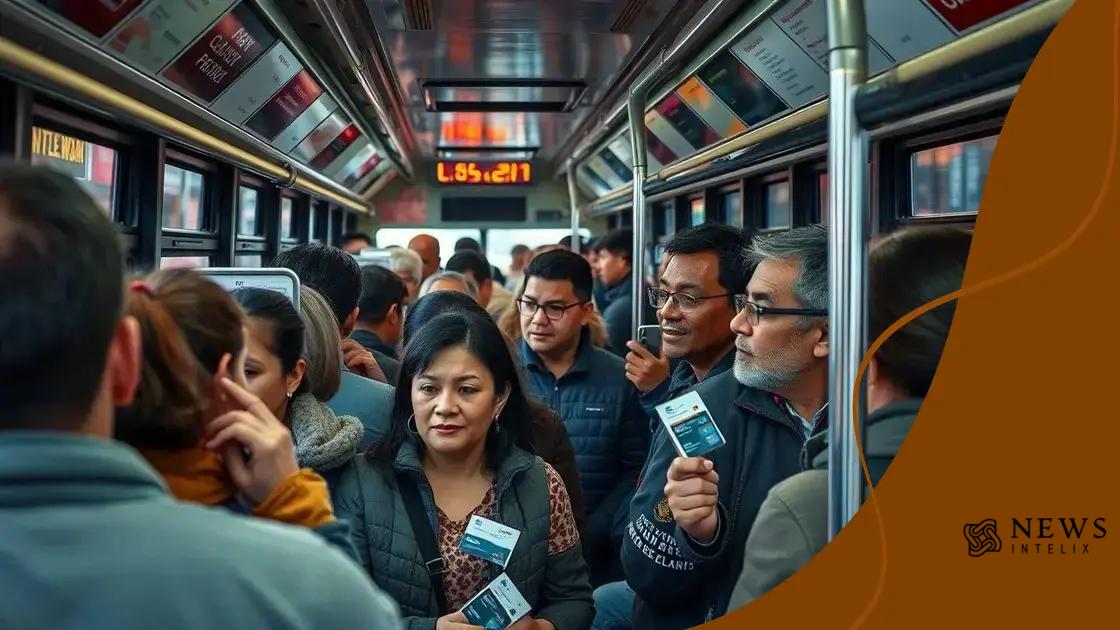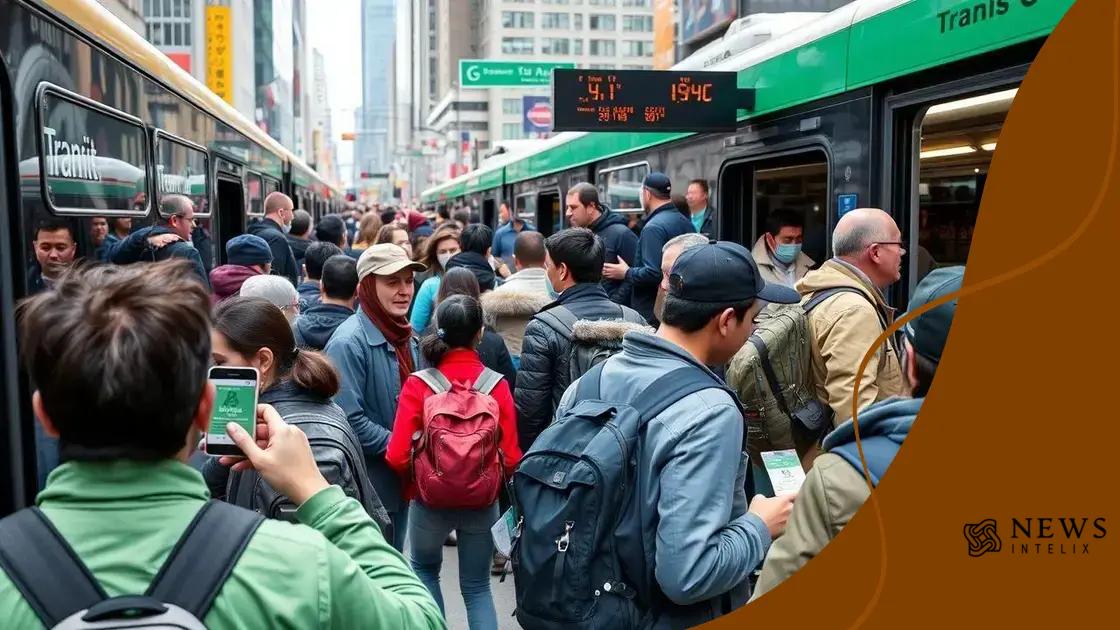Transit passes added to support commuters effectively

Transit passes improve urban mobility by providing affordable and convenient access to public transportation, promoting sustainability, and facilitating community engagement while addressing challenges like funding and technology integration.
Transit passes added to support commuters are more than just tickets; they can transform the daily grind into a smoother journey. Curious about how this impacts your commute?
Understanding transit passes and their purpose
Understanding transit passes is essential for today’s commuters. These passes play a crucial role in ensuring smooth transportation within cities. They offer convenience and savings, encouraging more people to use public transit systems.
What are Transit Passes?
Transit passes are prepaid tickets that allow unlimited travel within a designated area or for a specific time. They come in various formats, including monthly, weekly, or daily options, providing flexibility to users.
Benefits of Using Transit Passes
- Cost Savings: Users can save money by purchasing a pass instead of individual tickets.
- Convenience: Passes eliminate the need to carry cash or buy tickets regularly, making travel easier.
- Environmental Impact: Increased usage of public transportation reduces carbon emissions and helps the environment.
- Reduced Congestion: Using transit passes encourages more people to use public transit, decreasing road traffic.
Many cities offer specific programs to make transit passes accessible to different groups, such as students and low-income residents. By understanding these programs, commuters can better navigate their options.
For instance, some transit agencies provide discounts or free passes for seniors and students, greatly broadening access to public transport. Such initiatives not only make travel more affordable but also promote inclusivity within the community.
In many areas, electric and hybrid buses are also part of the transit system. These green vehicles are often included in the networks that accept transit passes, further enhancing the public transit appeal. As cities expand their efforts to go green, transit passes remain a key part of the solution.
Future of Transit Passes
Looking ahead, the evolution of transit passes may include innovative technologies, such as mobile apps and contactless payments, making the whole transit process even smoother. These advancements promise to cater to the growing demand for efficient public transportation.
How transit passes support local communities
Transit passes are more than just tickets; they support local communities in various impactful ways. These passes provide essential access to public transportation, making it easier for residents to engage with their communities.
Encouraging Public Transit Use
By offering affordable transit passes, cities encourage more people to use public transport instead of personal vehicles. This shift reduces traffic congestion, leading to less pollution and a healthier environment for everyone. More riders also mean more funding for local transit systems, reinforcing a cycle of improvement.
Fostering Economic Opportunities
Transit passes enable individuals to reach jobs, educational institutions, and essential services. With better access, people can take advantage of job opportunities that may be located outside their immediate neighborhoods. This connectivity is crucial in helping individuals achieve economic stability.
- Job Accessibility: Commuters can easily reach workplaces that were previously out of reach.
- Education: Students can attend schools and universities without transportation barriers.
- Healthcare Access: Easier trips to hospitals and clinics ensure better health outcomes.
Moreover, as more people utilize transit services, local businesses benefit from increased foot traffic. Shops and restaurants near transit hubs often see a boost in customers, leading to a vibrant local economy. This connectivity fosters a sense of community, encouraging residents to shop locally and support their neighborhoods.
Transit passes also play a key role in community events. Many public transport systems offer discounted or free fares during festivals and special occasions. This helps residents participate in local celebrations, building connections and pride in their community.
Strengthening Social Connections
The availability of transit passes can enhance social interactions. They make it easier for residents to visit friends and family, attend community meetings, and engage in social activities. These interactions contribute to a sense of belonging and unity within the community.
Benefits of using transit passes for commuters

Using transit passes offers numerous benefits for commuters, making daily travel easier and more efficient. These passes streamline the transportation process and encourage users to rely on public transport.
Cost-Effectiveness
One of the biggest advantages of transit passes is the cost savings. Commuters can save significant money compared to buying single tickets daily. Monthly and weekly passes often lower the per-trip cost, offering great value for frequent riders.
Convenience and Flexibility
Transit passes provide unmatched convenience. With a pass, commuters don’t need to worry about having exact change or standing in line to purchase tickets. This flexibility allows users to board transportation quickly, making their journeys smoother and more efficient.
- No need for cash: Passholders can travel without needing to carry cash, reducing stress.
- Access to multiple transit modes: One pass can cover buses, trains, and trams, simplifying travel across various platforms.
- Seamless transfers: Passes often allow for easier transfers between different modes of transit.
Additionally, using transit passes can lead to healthier lifestyles. Regular public transit usage encourages walking to and from stops, promoting physical activity. As a result, commuters often find themselves more active and engaged in their daily routines.
Moreover, many transit systems offer specific programs for commuters, such as employer-sponsored passes. This feature can reduce costs further while increasing public transit adoption among businesses and employees. Employers may also support eco-friendly practices, positively impacting community sustainability.
Community Engagement
Using transit passes helps create a sense of community among riders. Commuters often encounter other community members on their daily travels, allowing for social interactions that strengthen local ties. The transit system becomes a shared experience that connects people together.
As more commuters opt for transit passes, the demand for improved services increases, leading local authorities to invest in better transit infrastructure. This positive feedback loop benefits everyone, creating more reliable and efficient transit systems.
Challenges faced in implementing transit passes
Implementing transit passes comes with various challenges that public transit authorities must address. These challenges can affect how effectively transit passes serve the community.
Funding Issues
One of the primary challenges is securing funding for the development and maintenance of transit pass programs. Without sufficient financial resources, transit agencies struggle to provide the infrastructure needed for seamless operations. Budget constraints can limit the availability of passes, making it difficult to expand services.
Technology Integration
Introducing efficient technology for managing transit passes can also pose difficulties. Transit systems need to create reliable platforms for purchasing, using, and maintaining these passes. Implementing new technologies often requires training staff and educating the public, which can demand time and resources.
- Software compatibility: Outdated systems may not work well with new technologies.
- User adoption: Convincing consumers to switch to digital or contactless passes can be slow.
- Maintenance costs: Keeping technology up-to-date incurs ongoing expenses.
Additionally, maintaining user privacy while enhancing security for transit pass systems can be a balancing act. Riders may worry about personal information being compromised, leading to hesitancy in adopting new systems. It’s essential for transit agencies to establish trust through clear communication and robust security measures.
Another significant concern is the need for public outreach and education regarding how transit passes work. Many commuters might not be familiar with the benefits of using these passes or how they can be purchased. Effective communication strategies are key to encouraging use and engagement from the community.
Equity and Accessibility
Making transit passes accessible to all residents can be another challenge. Some populations may face barriers, such as lack of access to technology or limited mobility options. Ensuring that all community members can participate in transit pass programs is crucial for equitable transportation solutions.
As transit authorities face these challenges, they must work collaboratively with community members, stakeholders, and governments to find viable solutions that lead to successful implementation.
Future of transit passes and public transport
The future of transit passes and public transport looks promising as cities adapt to emerging technologies and changing commuter needs. With the rise of digital connectivity, transit passes are evolving beyond traditional paper tickets to become more user-friendly and accessible.
Integration of Technology
New technologies are transforming how commuters use transit passes. Mobile apps and contactless payment systems allow users to purchase and manage their passes directly from their smartphones. This convenience encourages more people to choose public transportation.
Data-Driven Improvements
Transit agencies are increasingly using data analytics to understand commuter behavior. By analyzing travel patterns, agencies can optimize routes and schedules to better meet the needs of riders. This data-driven approach ensures that public transport evolves in response to actual user demands.
- Smart ticketing: Future passes may integrate smart technology for easier validation and tracking.
- Personalized experiences: Notifications about delays or changes can be sent directly to users’ devices.
- Sustainability goals: Many transit services aim to reduce carbon footprints, enhancing the appeal of public transport.
As cities focus on sustainability, the integration of green technologies is becoming vital. Electric buses and alternative fuel vehicles are gaining traction, ensuring a cleaner environment for future generations. This shift supports the transition to greener public transit.
The future may also see more collaboration between cities and tech companies. Partnerships can lead to innovative solutions, such as integrated mobility platforms that offer a comprehensive view of all local transport options, including rideshares and biking solutions.
Equity and Inclusivity
Future transit passes will likely prioritize accessibility and inclusivity. Ensuring everyone can benefit from public transport is essential, especially for underserved communities. Improved communication and outreach efforts can promote awareness of transit pass programs, encouraging wider usage.
As urban populations grow, the challenge of traffic congestion remains prevalent. Public transport solutions, reinforced by effective transit passes, can help alleviate these issues. With ongoing investment and innovation, the outlook for transit passes and public transport is bright, paving the way for better commuting experiences.
FAQ – Frequently Asked Questions About Transit Passes and Public Transportation
What are transit passes used for?
Transit passes are used to provide access to various public transportation options like buses and trains, allowing commuters to travel conveniently.
How do transit passes save money for commuters?
Transit passes often offer lower rates compared to purchasing individual tickets, making daily commuting more affordable.
What technological changes are expected for transit passes in the future?
Future transit passes may include mobile apps and contactless payment options, enhancing convenience and user experience.
How can cities ensure equitable access to transit passes?
Cities can offer discounts, outreach programs, and ensure that transit options cater to underserved communities, promoting inclusivity.
